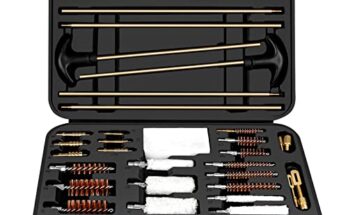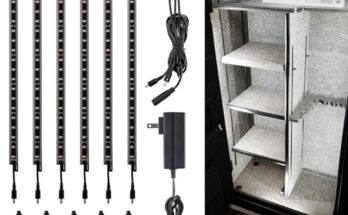An air rifle can shoot up to approximately 1,000 yards. Air rifles have a shooting range of up to 1,000 yards, making them suitable for various applications such as target shooting and pest control.
Whether you are a beginner or an experienced shooter, understanding the shooting range of an air rifle is important for accurate aiming and effective shooting. We will explore the factors that determine the shooting range of an air rifle, including the type of ammunition used, the power of the rifle, and the shooter’s skill level.
Additionally, we will discuss some safety considerations when using an air rifle at long distances. So, let’s dive in and find out how far an air rifle can shoot and what factors influence its range.
Factors Affecting Maximum Range
Maximum range of an air rifle is influenced by various factors like muzzle velocity, wind conditions, projectile weight, and trajectory. These factors collectively determine how far an air rifle can accurately shoot.
Factors Affecting Maximum Range When it comes to determining the maximum range of an air rifle, several factors come into play. Understanding these factors is crucial for both experienced shooters and beginners. By considering the projectile speed and weight as well as the environmental factors, you can determine how far an air rifle can shoot with accuracy. [H3] Projectile Speed and Weight The speed at which a projectile is discharged and its weight greatly impact the maximum range of an air rifle. Higher projectile speeds generally result in longer distances, as they allow the projectile to travel further before the force of gravity pulls it down. Similarly, a heavier projectile tends to retain its inertia better and can travel farther compared to a lighter one. [H3] Environmental Factors The environment in which you are shooting also plays a significant role in determining the maximum range of an air rifle. Wind speed and direction can greatly affect the projectile’s trajectory, causing it to veer off its intended path. Shooting in a closed environment with no wind provides the most accurate results. However, when shooting outdoors, it’s essential to consider the wind’s impact and make necessary adjustments to ensure accuracy. Table: Environmental Factors Affecting Maximum Range |Environmental Factor | Impact on Maximum Range| |———————|———————–| |Wind Speed | Can alter projectile trajectory, decreasing accuracy and range. |Wind direction | Changes in wind direction can cause the projectile to drift off course. |Temperature | Cold temperatures can decrease the air density, resulting in lower maximum range. |Elevation | Higher elevations can affect air density, impacting the air rifle’s maximum range. By carefully considering these factors, you can optimize your shooting experience and determine how far your air rifle can shoot with precision. Remember to account for projectile speed and weight, as well as environmental conditions such as wind speed and direction, temperature, and elevation. Overall, understanding and accounting for these factors will help ensure accurate and successful shooting sessions, maximizing the range and performance of your air rifle.Determining Maximum Range
Determining the maximum range of an air rifle involves considering factors such as the velocity of the projectile, the weight of the pellet, and atmospheric conditions. By analyzing these elements, you can determine how far an air rifle will shoot accurately.
Calculating Projectile Energy
When it comes to determining the maximum range of an air rifle, one crucial factor to consider is the projectile energy. Projectile energy refers to the amount of force exerted by the pellet as it is shot out of the barrel. It directly impacts the distance the pellet can travel before losing momentum. Calculating the projectile energy can help you estimate the maximum range of your air rifle.
So, how do you calculate projectile energy? It’s quite simple. First, you need to know the weight of the pellet in grains. Then, you’ll need the velocity of the pellet in feet per second (fps). Once you have these two values, you can use the following formula:
Projectile energy (in foot-pounds) = (pellet weight × velocity^2) ÷ 450240
Let’s say, for example, that your air rifle shoots a 14-grain pellet with a velocity of 900 fps. Plugging these values into the formula, you can calculate the projectile energy:
| Pellet Weight (grains) | Velocity (fps) | Projectile Energy (foot-pounds) |
|---|---|---|
| 14 | 900 | 30 |
According to the calculation, the projectile energy of your air rifle is 30 foot-pounds.
Accounting For External Factors
Calculating projectile energy is just the first step in determining the maximum range of your air rifle. External factors also play a significant role in the pellet’s flight and range. These factors include wind resistance, air density, temperature, and elevation. Ignoring these factors can lead to inaccurate estimations of maximum range.
Wind resistance, for instance, can greatly affect the trajectory of the pellet. The wind’s speed and direction should be considered when shooting outdoors. Additionally, air density changes with altitude and atmospheric conditions. Higher altitudes and extreme temperatures can impact the pellet’s ability to maintain its velocity, limiting its range.
While calculating projectile energy can provide a baseline estimation of maximum range, accounting for external factors ensures a more accurate and realistic assessment. To get a precise understanding of your air rifle’s maximum range, it’s crucial to consider and adjust for these external factors accordingly.
Enhancing Maximum Range
An air rifle’s maximum range is impacted by various factors, including the type of pellets used and the setup of the rifle itself. By optimizing these elements, you can significantly extend the shooting range of your air rifle, enhancing its overall performance and accuracy.
Choosing The Right Pellets
When selecting pellets for your air rifle, it’s crucial to consider their weight, shape, and material. Heavy pellets generally provide better stability and accuracy over longer distances, whereas hollow point or pointed pellets may offer improved penetration and impact at extended ranges.
Optimizing Rifle Setup
To maximize the range of your air rifle, paying attention to its setup is essential. Consistently maintaining proper barrel cleanliness and ensuring that the sights or scope are precisely calibrated are crucial factors that can significantly enhance the rifle’s performance and effective range.
Safety Considerations
Air rifles are versatile weapons, but safety must always come first. Proper precautions are crucial to prevent accidents and injuries.
Risk Of Over-shooting
Always be mindful of the potential risk of over-shooting when using an air rifle. Bullets can travel great distances and pose a danger to people and animals beyond the intended target.
Importance Of Proper Backdrop
Select a backdrop that can effectively stop the projectile in case of a mishap. Avoid shooting into the air or towards hard surfaces that can cause ricochets.
Legal Regulations
Legal regulations regarding air rifle use are crucial to understand to avoid any potential legal issues. Here’s what you need to know:
Understanding Local Air Rifle Laws
Before using an air rifle, research and comprehend the laws in your area to ensure compliance.
- Check local ordinances regulating air rifle use.
- Follow any age restrictions for users.
- Understand required permits or licenses.
Respecting Private Property
Always respect private property when using an air rifle to avoid trespassing violations.
- Seek permission from property owners before shooting on private land.
- Do not shoot towards neighboring properties.
- Avoid shooting near occupied buildings.
Real-life Applications
Air rifles have varying shooting ranges, with some models capable of shooting projectiles as far as 1,000 yards. The range of an air rifle largely depends on its power and the projectile used. Factors like wind speed, elevation, and air density can also affect the distance a projectile travels.
Real-life Applications Hunting Scenarios In real-life hunting scenarios, air rifles prove to be Versatile and Powerful Tools. The Air Rifle’s precision and long-distance shooting capabilities make it an essential asset for small game hunting. Targeting pests such as rats, squirrels, and rabbits in agricultural environments requires accuracy and stealth, both of which are offered by air rifles. When Choosing an Air Rifle for Hunting, it’s crucial to consider the caliber and shooting range, ensuring humane and ethical hunting practices. Target Shooting Competitions Air rifles play a significant role in competitive shooting events, providing participants with an opportunity to showcase their Accuracy and Precision. The challenging nature of these competitions requires the use of advanced air rifles capable of delivering consistent and reliable performance. In competitive shooting, the shooting range, accuracy, and stability of an air rifle are crucial factors that can influence the outcome of the competition. Participants must carefully select the air rifle that best suits their individual shooting style and preferences, ensuring that they can achieve their full potential in the competition. Overall, air rifles have diverse real-life applications, ranging from hunting scenarios to competitive target shooting events. Their versatility and precision make them valuable tools for various activities, offering users the opportunity to excel in their chosen pursuits. Whether it’s hunting small game or participating in a competitive shooting competition, the capabilities of air rifles continue to be appreciated by enthusiasts and professionals alike.Frequently Asked Questions For How Far Will An Air Rifle Shoot
How Important Is The Caliber In Determining The Shooting Range?
Caliber plays a crucial role in determining an air rifle’s shooting range. A higher caliber typically results in greater shooting distance and impact on the target.
What Factors Affect The Shooting Distance Of An Air Rifle?
Several factors influence an air rifle’s shooting distance, including caliber size, velocity, projectile weight, and air pressure. These factors combined determine the overall range of the rifle.
Can Modifying The Rifle Increase The Shooting Range?
Yes, modifying an air rifle with enhancements like a longer barrel or adjustable stock can potentially increase its shooting range. However, always consult with a professional before making modifications.
How Does Air Pressure Impact The Shooting Range Of A Rifle?
Air pressure is vital for propelling the projectile in an air rifle. Maintaining the correct pressure level ensures optimal performance and a consistent shooting range for the rifle.
Conclusion
Understanding the maximum shooting distance of an air rifle is crucial for both safety and practicality. By considering the factors that affect the range, such as the type of rifle and ammunition used, shooters can make informed decisions and enjoy their sport responsibly.
With the right knowledge, enthusiasts can maximize their shooting experience while minimizing risks.

